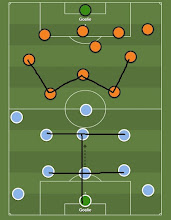Only a very few notable star players were awarded Copa America’s MVP twice.
Copa America 2024 is heading to the final. The reigning champions,
Argentina, are set to take on Colombia at the summit. It is bound to be a tough
match for both sides, and they might have to go through a shootout to decide
the winner again, just like the last edition held in the USA, the Copa America
Centenario. This clash would also be their first meeting in the final.
In the tournament’s history, there have been a few names who have won the
best player award twice. The last one is surely Lionel Messi. He was first
awarded such an accolade officially in 2015. However, he refused it due to the heartbreaking defeat to the host Chile in the final. The second one was
undoubtedly three years ago, when he was instrumental in breaking the spell of
a series of cursed failures at the international level. This year, Messi could
break another record should he win another MVP. However, such is rather
unlikely, as his form has no longer been at the same level as in the 2021
edition. He has only registered one goal and one assist so far.
The Argentine talisman is definitely not the first to win the best player
award twice. Three other names had done it in the past. Here are those notable
Copa America stars with two MVP awards:.
Manuel Seoane (Argentina)
The Argentine striker was the earliest to win the Copa America as a player
and a manager. He was part of the winning squad in the 1925, 1927, and 1929
editions. In 1925, he was even named the top scorer by netting six times in the
competition and the best player, whereas in 1929, Seoane only played one game,
the opener against Peru. He was also awarded the MVP in 1927, but only netted
twice in the tournament.
In the 1937 edition, he brought Albiceleste to lift another trophy when hewas in the dugout. The former Independente man guided them to thump Brazil 2-0
in the playoff final. At that time, Copa America was still using the
round-robin format. They shared the same points as Selecao after collecting
four wins and one loss. The champions had to be decided by a playoff.
Jose Nasazzi (Uruguay)
He was La
Celeste’s captain when they won the first FIFA World Cup edition in 1930.
Nasazzi was also named the best player in the Copa America in 1923 and 1935, ashe played well in all games in those two editions, in which Uruguay was unbeaten.The former Bella Vista and Nacional Montevideo man was also an integral part of
his nation’s success in winning gold medals twice in the 1924 and 1928 Summer
Olympics.
After his
retirement, he was given a chance to take charge of La Celeste from 1942 to
1945. The former defender led them in the Copa America 1945 as the reigning
champion but failed, as they only finished fourth in the final standings.
Enzo Francescoli (Uruguay)
The former
Uruguayan playmaker was the last one to win Copa America’s MVP twice before
Messi. He was awarded in the 1983 and 1995 editions, in which Uruguay clinched
the title too. Francescoli scored only one in the former and bagged twice plus
one assist in the latter. He also brought La Celeste to defend the title in 1987,
where he only contributed one assist. Uruguay 1995 was his last major
international tournament.
The former
River Plate man appeared twice in the FIFA World Cup, in 1986 and 1990. Yet,
his performance was nowhere close to his peak form in the Copa America, as
Uruguay could only progress to the round of 16 on both occasions. He also only
netted once without an assist.
His career in
Europe was widely remembered during his stint in Cagliari, when he helped them
finish sixth in the Italian Serie A. Before arriving in Sardinia in 1990,Francescoli played for Ligue 1’s lower-table team, RC Paris, which went
bankrupt in the 1980s, and Marseille, where he won his only league title in
Europe. His last club there before he came back to River Plate was Torino,
where he spent only one season in 1993/94. In his second stint with Los
Millonarios, El Principe won domestic league titles, the Copa Libertadores 1996
and the Supercopa Sundamericana 1997, which is equal to the UEFA Super Cup.



Comments
Post a Comment